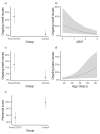Persistent Post-COVID-19 Olfactory Dysfunction and Its Association with Autonomic Nervous System Function: A Case-Control Study
- PMID: 39851468
- PMCID: PMC11765322
- DOI: 10.3390/diseases13010004
Persistent Post-COVID-19 Olfactory Dysfunction and Its Association with Autonomic Nervous System Function: A Case-Control Study
Abstract
Background: Following the Coronavirus Disease 2019 (COVID-19) pandemic, many patients have reported ongoing smell and taste issues. This study aims to investigate the prevalence of olfactory and gustatory dysfunction among patients with a history of COVID-19 and its association with autonomic dysfunction and disability.
Patient and methods: This case-control study included a COVID-19 group (n = 82) and a control group (n = 82). Olfactory dysfunction, including parosmia and taste problems, was explored using self-reports and the Quick Smell Identification Test (QSIT). The association between post-COVID-19 disability severity and taste and smell alterations was also analyzed. Moreover, autonomic function was evaluated using the Composite Autonomic Symptom Scale-31 (COMPASS-31) to assess the association between autonomic and olfactory dysfunction.
Results: Significantly higher rates of ongoing smell (26.8%) and taste (14.6%) dysfunction were reported for the post-COVID-19 group compared to the control group. Post-COVID-19 patients reported 36.6 times more smell issues and 8.22 times more taste issues than controls. Parosmia scores were significantly worse in the post-COVID-19 group, while QSIT scores showed no significant difference between the groups. However, those with worse QSIT scores exhibited significantly more ongoing smell issues. No significant association was observed between disability and altered smell or taste. Higher secretomotor dysfunction scores were significantly associated with abnormal QSIT scores and worse parosmia scores; the other domains of the COMPASS-31 scale showed no significant associations.
Conclusions: The findings indicated a potential link between autonomic and olfactory dysfunction. Further studies are needed to elucidate the mechanisms underlying persistent olfactory and autonomic dysfunction in post-COVID-19 patients.
Keywords: autonomic dysfunction; post-COVID-19; subjective and objective smell tests.
Conflict of interest statement
The authors declare no conflicts of interest.
Figures



Similar articles
-
Psychophysical assessment of olfactory and gustatory function in post-mild COVID-19 patients: A matched case-control study with 2-year follow-up.Int Forum Allergy Rhinol. 2023 Oct;13(10):1864-1875. doi: 10.1002/alr.23148. Epub 2023 Mar 15. Int Forum Allergy Rhinol. 2023. PMID: 36852674
-
COVID-19-Related Quantitative and Qualitative Olfactory and Gustatory Dysfunction: Long-Term Prevalence and Recovery Rate.ORL J Otorhinolaryngol Relat Spec. 2023;85(2):67-71. doi: 10.1159/000525861. Epub 2022 Sep 5. ORL J Otorhinolaryngol Relat Spec. 2023. PMID: 36063810 Free PMC article.
-
A quick test to objectify smell and taste dysfunction at home: a proof of concept for the validation of the chemosensory perception test.Chem Senses. 2023 Jan 1;48:bjad033. doi: 10.1093/chemse/bjad033. Chem Senses. 2023. PMID: 37586396 Free PMC article.
-
Olfactory and Gustatory Recovery Time Evaluation of COVID-19: A Systematic Review and Meta-Analysis.Acta Med Indones. 2025 Jan;57(1):18-43. Acta Med Indones. 2025. PMID: 40263685
-
Anosmia: an evolution of our understanding of its importance in COVID-19 and what questions remain to be answered.Eur Arch Otorhinolaryngol. 2021 Jul;278(7):2187-2191. doi: 10.1007/s00405-020-06285-0. Epub 2020 Sep 9. Eur Arch Otorhinolaryngol. 2021. PMID: 32909060 Free PMC article. Review.
References
-
- Fernández-de-las-Peñas C., Palacios-Ceña D., Gómez-Mayordomo V., Florencio L.L., Cuadrado M.L., Plaza-Manzano G., Navarro-Santana M. Prevalence of post-COVID-19 symptoms in hospitalized and non-hospitalized COVID-19 survivors: A systematic review and meta-analysis. Eur. J. Intern. Med. 2021;92:55–70. doi: 10.1016/j.ejim.2021.06.009. - DOI - PMC - PubMed
-
- Kostka K., Roel E., Trinh N.T.H., Mercadé-Besora N., Delmestri A., Mateu L., Paredes R., Duarte-Salles T., Prieto-Alhambra D., Català M., et al. The burden of post-acute COVID-19 symptoms in a multinational network cohort analysis. Nat. Commun. 2023;14:7449. doi: 10.1038/s41467-023-42726-0. - DOI - PMC - PubMed
LinkOut - more resources
Full Text Sources

